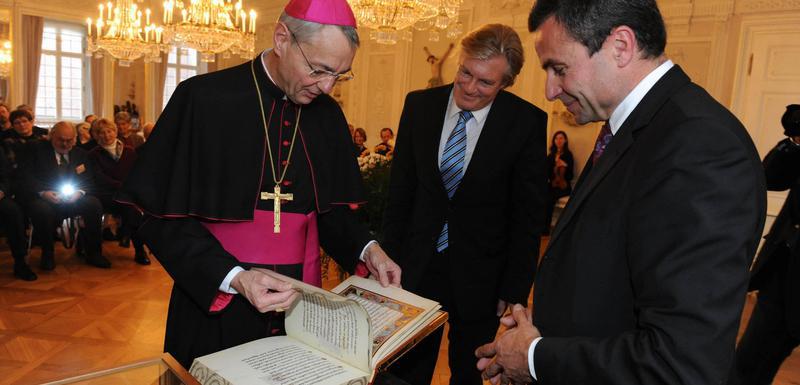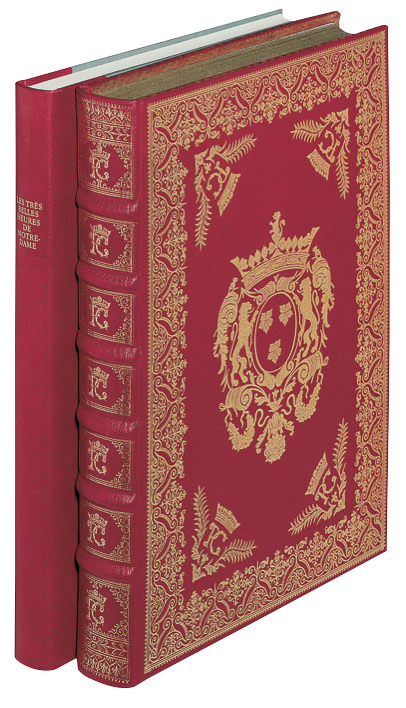In the age of digital revolution, facsimile editions make it possible for the reader to stop for a moment, leaving behind the information overload of the everyday life. The facsimile making process thus aims at offering a glimpse of eternity, bringing reading back to its ancient dimension of silence and contemplation. So, sit back and enjoy the story of Faksimile Verlag!

Fac Simile: macht es ähnlich is the title of a short book written by Manfred Kramer, former Director at Faksimile Verlag. The book describes the story of the publishing house and the development of manuscript facsimile production during its glorious years.
The good folks at Facsimile Finder have translated it for you, and are going to publish it in short chapters during the next weeks. Follow us!
To be able to recreate exact copies of medieval tomes, early publishers had to invent new techniques and to work patiently in order to make sure that the reproduction could hardly be distinguished from the original.
Following the history of Faksimile Verlag, this guide will see you through the history of the facsimile along the centuries, briefly explaining the process beyond the books presented to the public.
So, get ready for a journey in a mostly unexplored world. Grab your favorite snack, make yourself comfortable and let us begin.
Forewords of Armin Sinnwell, Head of Faksimile Verlag
The world of books is caught up in the age of the digital revolution. More and more often, any kind of subjects are no longer printed; instead, they are developed as e-books, blogs, published on websites and other digital formats, not to mention the world of games and social networks. Pessimists see the book’s demise in all this. This seems to be due to the changed reading habits of both children and adults.
However, a slowing phenomenon seems to be siding the speeding up of product, content and market: confronted by the overweening digital powers, people desire to assert their individuality, live according to their own lights and nurture their interests. The reading of books is part of ancient ways of human expression and experience, like the contemplation of art made in a silent moment.
Our intention is to present a glimpse of the process, the history, the difficulties that reproducing an ancient and precious manuscript entails.
The unhurried person can experience a quantum of eternity in a single moment. And where better to experience this eternity than in the company of books, that deal with eternity themselves, since they date from ages past? Since 1974, Faksimile Verlag has devoted its work to the effort of making “images of the eternal” (to paraphrase Jacob Burckhardt‘s famous dictum) and to render them accessible to a wider public. These images are preserved in books that have been the conveyers of information, inspiration and devotion for hundreds of years.
“The book as repository” is a tricky thing: in contrast to large-format panel or canvas paintings, the art in a book cannot be hung on the wall; the book’s pages are often so small that magnifiers at times are supplied along with reproductions, and both the colors as well as the descriptive material are sensitive and suffer damage with every use.
Hence, the more important is it for there to be a faithful copy that permits using the unicum, which, for conservation reasons, is rarely accessible. The reverse applies, as well: to avoid frequent handling of the original and halt its deterioration. In this endeavor – a blessing for libraries as much as bibliophiles –enormous technical progress comes to our aid. The facsimile may not be able to convey the original’s aura, but, thanks to advanced reproduction and printing processes, this drawback can be minimized to the point where it far outweighed by its advantage, namely access for the bibliophile.

Book art often stands in the shadow of more prominent art forms. This is why, for decades, those who occupied themselves with it led a marginal existence. By now, book illumination has emancipated itself as an object worthy of scholars and collectors. With the years, exhibitions of book paintings have become as normal and (nearly) as beloved as have their big cousins for painting and sculpture.
Book illumination actually enjoyed an advantage all along: the smaller format, the intimate framework, offered an ideal space for experimentation to artists who had to work under much more conventional constraints out in the open. This is why it is often a book that harbors the more unexpected artistic enjoyment, the more original composition and the more enchanting detail.
The present work conveys the history of book art in short form by basing it on the history of important facsimile editions. We can say with some pride that the Faksimile Verlag has in large measure helped to write this history.
Borrowing from the well-known book title “Where do books come from?” this story also describes how humankind’s treasures come from climate-controlled, hermetically sealed repositories to our bookshelves and tables, for our edification and enjoyment. The “fac simile,” the facsimilizing, is a protracted and expensive process that always throws down new challenges and that profits from technological progress as much as it promotes and cross-fertilizes it. Only someone who knows the effort involved can properly appreciate the results. And someone who knows how to treasure a facsimile edition will always sense the firm ground of Western heritage under his feet, even amid the digital revolution.
Coming Next..
Here is a little summary of the soon-to-be-published posts part of Faksimile Verlag’s Story:
- The Story of Faksimile Verlag, Publisher of Fine Facsimile Editions – part 1
- Facsimiles and the Role of Illuminated Manuscripts: the Story of Faksimile Verlag – part 2
- What is a Facsimile: the Story of Faksimile Verlag – part 3
- How it All Began: the Story of Faksimile Verlag – part 4
- From Analog to Digital: the Story of Faksimile Verlag – part 5
- The Making Process of a Facsimile: the Story of Faksimile Verlag – part 6
- Challenges and Magic of Facsimile Production: the Story of Faksimile Verlag – part 7
- Binding, Paper, and Commentary: the Story of Faksimile Verlag – part 8
- Treasures of the Past: the Story of Faksimile Verlag – part 9
- Gems of the Middle Ages: the Story of Faksimile Verlag – part 10
- Flemish, Burgundian, and Biblical Art: the Story of Faksimile Verlag – part 11
- Middle Ages through the Manuscripts: the Story of Faksimile Verlag – part 12
- The Challenges of Gothic Art: the Story of Faksimile Verlag – part 13
- Ottonian and Charlemagne’s Art: the Story of Faksimile Verlag – part 14
[/newsletter]


